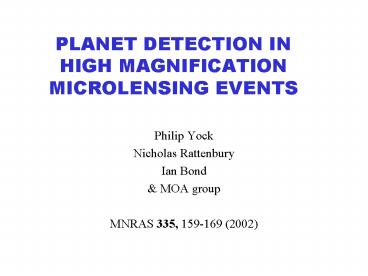PLANET DETECTION IN HIGH MAGNIFICATION MICROLENSING EVENTS PowerPoint PPT Presentation
1 / 19
Title: PLANET DETECTION IN HIGH MAGNIFICATION MICROLENSING EVENTS
1
PLANET DETECTION IN HIGH MAGNIFICATION
MICROLENSING EVENTS
- Philip Yock
- Nicholas Rattenbury
- Ian Bond
- MOA group
- MNRAS 335, 159-169 (2002)
2
Maximum possible magnification-Max mag ? (2?rE
? rS)/?rS2 rE/rs ? 1000(S. Liebes, Phys. Rev.
133B, 835, 1964)
- Observer Lens
Source (moving)
3
Event rates-
- 10 events with magnification 100 were found
in 2001 - similar event rates occurred in 2002 and 2003
- I. Bond et al, MNRAS, 331, L19, 2002
- http//www.roe.ac.uk/iab/alert/alert.html
4
The primary effect of planetary deflectors bound
to stars will be to slightly perturb the lens
action of these stars Liebes (Phys. Rev.
133B, 835, 1964)
- Planet orbiting the lens star-
5
Calculations of planetary perturbations-
Griest Safizadeh, ApJ 500, 37, 1998 Computed
planetary perturbations in events with Amax
10 Rattenbury et al, MNRAS 335, 159, 2002
Computed planetary perturbations in events with
Amax 100
6
- Amax 80, sep 0.8rE, ice giant at 30
7
- Amax 80, sep 0.8 rE, ice giant at 60º
8
Amax80, sep 0.8 rE, ice giant at 90
- Amax 80, sep 0.8 rE, ice giant at 90
9
planet
Lens star
?
Source track
ll
?
theta
?
?
10
Planets in the lower hemsiphere produce mirror
image perturbations-
- Amax 80, sep 0.8 rE, ice giant at 210
11
Terrestrial planets-
- Amax 80, sep 0.8 rE, Earth mass planet at 60
12
Regions of detectability-
- If Amax ? 100, then-
- Terrestrial planets detectable from 0.8-1.3 rE
- Ice giants at gt 0.4 rE
- Gas giants anywhere
- (Further details at MNRAS 335, 159, 2002)
13
Exceptional regions-
- Loss of sensitivity at 0 and 180-
14
Multiplanets-
- Planets at 120 and 150, both 4? Earth mass
15
Three planets-
- Earth at 150, 4? Earth at 60, Neptune at 300
16
Mass-separation and reflection degeneracies-
- Planet at 1.5rE, mass ratio 5?10-4
17
- Conclusion - High magnification microlensing
events are promising for studying extrasolar
planets- - Sensitivity to gas giants is 100
- Sensitivity to ice-giants is substantial
- Sensitivity to terrestrial planets is
significant
18
Abundance measurements-
- In a few years-
- Significant measurements possible for ice-giants
in the Galaxy - Rudimentary measurements may be possible for
terrestrial planets
19
Requirement-
- The peaks of high magnification events need to be
monitored intensively

